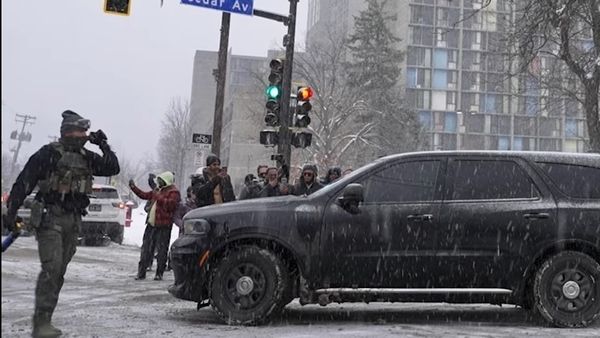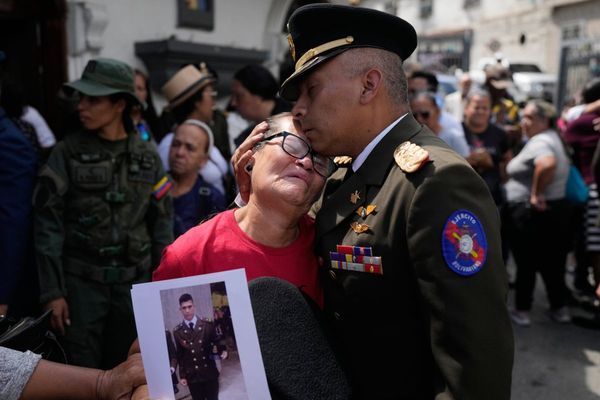
It is hard to imagine the Iranian regime collapsing without violence, supporters of which should be assumed willing to kill and die
Opinion: Recent events have raised hopes for a freer and more democratic government in Iran. The death in police custody of Mahsa Amini, a young Kurdish woman, has sparked a massive wave of protests that increasingly looks like a revolution. The Norway-based organisation Iran Human Rights reports that protesters have been killed not only in Amini’s Kurdish home province, but in 21 of 31 provinces.
Western countries have no reason to support or defend the Islamic regime and every reason to sympathise with Iranians who seek freedom from its harassment, oppression and violence, and its morality police. That said, revolutions are unpredictable things. If the Iranian regime should fall, what would take its place?
To appreciate why the fall of the Islamic Republic might go horribly wrong, one must understand that the regime is highly unusual. The constitution of the Islamic Republic of Iran derives from principles of Twelver Shia Islam, a religion not well understood outside the Middle East. Indeed, it is a minority religion even in the Islamic world, most of which is Sunni.
Shia Islam differs from Sunni Islam in the belief that the Prophet Muhammad’s rightful successors should have been his blood relatives, following hereditary dynastic succession. When Muhammad died in 632, the state he had established was expanding rapidly. Muhammad fathered no sons, but some early Muslims believed his rightful successor was Ali ibn Talib, his paternal cousin and son-in-law, thereafter Ali’s sons (Muhammad’s grandsons), and so on through their male descendants.
In practice, the early Islamic caliphate chose Muhammad’s successors from his closest companions. Ali, as one of those companions, became Muhammad’s fourth successor, but his death in 661 sparked a civil war in which his children, Muhammad’s grandchildren, were defeated and massacred. Muhammad’s great-grandchildren and further male descendants survived, but were held under close surveillance and typically died by poison on the orders of Sunni caliphs.
Eventually, one of Muhammad’s direct male descendants, Muhammad ibn Hasan, who according to Shia reckoning would have been Muhammad’s 12th successor, went into hiding. In his last message to his followers, written in 941, he promised to reappear “after a very long time when people will have grown tired of waiting and those who are weak in their faith will say: What! Is he still alive?”
Twelver Shia Islam, named after the 12 known successors, ascribes legitimate political power to the hidden 12th successor, known as the 12th imam, and only to him. The hidden imam is the legitimate ruler of the entire world. Devout Twelver Shia ardently await his return and global rule, much as devout Christians ardently await the second coming of Jesus and the establishment of his kingdom.
Shia jurists have developed theories of good government in the absence of the 12th imam. The key concept, developed in the 16th Century, is the “Guardianship of the Jurist”. The basic idea is that mullahs – religious scholars knowledgeable in Shia religious law –can wield legitimate authority in his absence.
The current Iranian system of government, founded by the Ayatollah Khomeini, institutionalises the Guardianship of the Jurist. Articles 72 and 96 of the Iranian constitution establish a “Guardian Council” composed of religious experts and grant it the right to veto parliamentary legislation. The Guardian Council also approves all candidates for parliamentary election.
Any government so dominated by religion is typically experienced as oppressive by religious minorities, but less devout members of the majority Shia community also chafe under the rule of the mullahs. The mass protests rocking the country are irrefutable proof of popular dissatisfaction. Iranian citizens have recently taken to showing their anger by knocking off the turbans from the heads of passing clergymen.
Nevertheless, it is hard to imagine the Iranian regime collapsing without violence. Shia Islam has survived more than a millennium and it cherishes a strong strain of martyrdom. Supporters of the Iranian regime, in short, should be assumed willing to kill and die.
Even if the Iranian leadership wanted to step offstage, it is difficult to see how it could. The protesters’ chant of “death to the dictators” offers the existing leadership little chance of a peaceful retirement. The Iranian government, furthermore, has few foreign friends. Where could Iran’s leaders find refuge? If politicians facing crisis can neither retire nor flee, it should not be surprising if they fight.
One possible outcome of the Iranian protests is a civil war, bringing with it death, destruction, and suffering to eclipse the violence presently being inflicted. The example of Syria’s Arab Spring in 2011 ought to be sobering. Protests against the appalling violence of the Syrian security services led to mass protests and Syrians too chanted the slogan “death to the dictator”. Backed into a corner, the Assad regime fought for its life and ultimately prevailed. The human cost has been terrible, with millions made refugees and an estimated 306,000 civilian casualties.
Another possible outcome is that the protest movement may simply be suppressed. Such was the fate of the “Green movement” in 2009, sparked when religious conservatives rigged an election to keep a reformist candidate from power. After enough protesters were arrested and tortured, and at least 100 people killed, the protest movement flagged. The current protests are much larger, but may still be put down if regime violence escalates.
Let us, however, consider the possibility the protests succeed. Let us imagine Iranian army units join the protesters and the mullahs fall. What if essentially free and fair elections are held? Might not Iran develop into a genuinely democratic state that respects human rights, promotes the rights of women, develops good relations with its neighbours, and becomes a force for peace in the world? Unfortunately, nationalist violence seems a likelier outcome.
If the Islamic government falls, its successor will almost certainly claim to represent the popular will and thus legitimate itself with reference to the “national interest”. But which national interest? The citizens of a democratic Iran will quickly discover they do not all imagine the “national interest” in the same way. Iran is an ethnically diverse country with a history of separatist movements. Farsi visions of national liberation will differ from minority Kurdish, Azeri, or Balouchi visions of national liberation. Iran may accommodate these different visions. But it may also be riven with separatist movements. A Farsi nationalist backlash is also a danger.
A civil war to overthrow the Islamic regime could thus transform into an ethnic civil war. Plausible nightmare scenarios are easy to imagine. Could the suppression of protests in Iranian Azerbaijan provoke the republic of Azerbaijan to send soldiers over the border? If successionist revolutionaries gain control over Iranian Kurdistan or Iranian Balouchistan, might the governments of Turkey or Pakistan intervene, so as to avoid setting precedents for Turkish Kurdistan or Pakistani Balouchistan?
Faced with these many dangers, what should Western powers be doing? There are few obvious options at present. Some public figures have declared their solidarity with protesters: the English rock band Coldplay, for example, played a revolutionary song at a recent concert in Argentina. Such displays of solidarity, however, do not topple determined governments.
Direct military intervention would almost certainly be counterproductive. Opportunities for useful covert action, while opaque to civilian observers, may be visible to experts with security clearances and intelligence briefings. But the sordid history of British and American intervention in Iranian affairs has undermined their ability to influence events. The dangers of playing the white saviour almost certainly outweigh the benefits.
Western powers might, however, consider contingency planning in case a new Iranian government emerges. A new Iranian leadership may be prepared to consider bold changes in policy and Western countries may ponder how best to seize any opportunities that may develop. Perhaps it is time to prepare drafts of the legislation necessary to lift sanctions and welcome back a more democratic Iran into international organisations.
Aid packages and other goodwill gestures may also be prepared in advance. Above all, however, Western public opinion should be cognisant of how many different ways the current protest movement could end badly. The war in Ukraine understandably preoccupies Western governments, but the fraught situation in Iran also demands attention.







